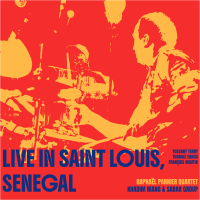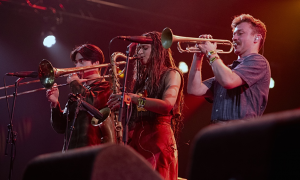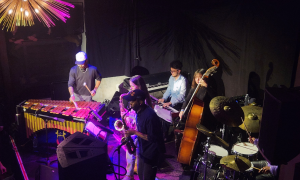Home » Jazz Articles » Live Review » Monterey Notebook 2007, Part 3: Sunday
Monterey Notebook 2007, Part 3: Sunday
Sliding into an amorphous, greasy version of a 12-bar groove, Coleman and associates draw a straight, glowing line directly from the most fundamental roots of jazz to its impenetrable outskirts.
Banana Slug String Band: Getting Dirty
Sunday, 1:20 p.m.—Garden Stage
"Okay, put down your beers and hold up your munchers!" says the man calling himself Doug Dirt. Several dozen members of the audience comply, raising their arms and working their fingers like snapping jaws. "Great," the man yells encouragingly. "And you guys over here? You're sunbeams!" Huh? What the heck is going on here?
The colorful Mr. Dirt (nee Greenfield) is part of the Banana Slug String Band, and he's getting his audience primed to help out in a song about decomposition—that's right, rot. Or more to the point, the process by which dirt is made. Soon the entire audience is hidden by a waving, snapping mess of arms—their movements a rhythmic simulation of organic decay—as the funky Slugs clomp through lyrics about bugs, bacteria and chemical breakdown.
This is what the Slugs do, promoting environmental education through jazz, blues and rock-based ditties aimed primarily at kids. Plenty of tykes are on hand, but more than a few adults have joined the party too. Elsewhere, the first of many high school student ensembles are beginning their sets and a sober panel discussion of festival co-founder Ralph Gleason's many contributions is getting underway. But with the sun shining brightly on a gorgeous Northern California day and rain just a bad memory, it's hard to leave the silly Banana Slugs, even if they are singing about rot.
Smith Dobson V: In the Neighborhood
2:15 p.m.—Coffee House Gallery
Out of the glaring sunshine, vibraphonist Smith Dobson V is filling the shadowy Coffee House Gallery with ringing, spiraling streams of notes.
A native of nearby Santa Cruz and a member of that city's first family of jazz, Dobson guides an orderly quintet through gently rolling grooves, tossing off casual, liquid solos. The band comes together beautifully in the closing ensemble passage of a nameless bossa nova, spinning lazily around Dobson's clear, bell-like patterns.
Switching gears now, bassist Devin Hoff and pianist Dahveed Behroozi go electric for "Wolverine," a catchy but oddly shaded lounge-pop melody over a steady surf-rock beat from drummer Vijay Anderson. "G. G. Drift" follows in the same vein, blending 1960s spy-music atmosphere with hints of carnival music. The tune never quite takes off, coming across as stiff despite Dobson's gliding breaks and some crunchy guitar accents from John Finkbeiner. But like much of the music presented in this intimate venue, it is unique.
Ornette Coleman: Vortex
2:45 p.m.—The Arena
The sound of Ornette Coleman's saxophone flares from the Arena stage, spilling from a roiling mass of bass tones in short, disconnected bursts. Followers of this avant-garde icon are by now accustomed to the idea of hearing Ornette with two bassists, as on his Pulitzer-winning album Sound Grammar, but now he has three. Tony Falanga and Charnett Moffett flank the leader, creating thick, elastic sheets of bowed and plucked acoustic tones, while Al McDowell sits off to the side with an electric bass, reacting directly to Coleman's abstract blues and plaintive cries. Denardo Coleman, Ornette's son and longtime drummer, is concealed directly behind his father. But his invincible, volcanic rhythms—at once tribal, hammering and otherworldly—wrap the band in a whirling vortex of energy.
From time to time the dapper Coleman reaches for a nearby trumpet, adding mournful, gently arcing footnotes to his melodic explorations. Or grabbing his violin, Coleman deftly merges with his three bassists in a fast, tense scribbling.
Coleman's deep-rooted connection to the blues is hardly a secret, but it's still a jolt when this influence leaps into the foreground. Sliding into an amorphous, greasy version of a 12-bar groove, Coleman and associates draw a straight, glowing line directly from the most fundamental roots of jazz to its impenetrable outskirts. Minutes later, the group will find another continuity, improvising on Bach's Solo Cello Suite No. 1 in G Major and taking it to outer space.
Hot Club of San Francisco: Jumping like Django
4:00 p.m.—Garden Stage
Sparkling, exuberant and infectious, the Hot Club of San Francisco is reeling off toe-tapping Gypsy swing that harkens back to another land and another era. Acolytes of the school founded by legendary guitarist Django Reinhardt in the cafés of Paris before World War II, the Hot Club shares its passion with an audience that at first seems a bit mystified, but soon has Django fever.
Lead guitarist Paul Mehling is a native of the Monterey peninsula, and his glee at appearing on the Garden Stage is apparent as he keeps up a humorous patter between tunes and spars with the planes flying overhead ("there goes the live album," he quips).
On "Flambee Montalbanese," an iconic waltz-musette originally by Gus Viseur, the music trips merrily along, Mehling's guitar lines prancing around Evan Price's sweet violin before each flies out for an uplifting solo. Slowing down for Stephane Grappelli's "Souvenir de Villingen," Price hits the sweet spot, his weeping solo momentairly silencing the chatty outdoor crowd. But it's soon back to the kind of quick, chunky swing and upbeat vibe that gives "Django music" its greatest appeal.
Although drawing its inspiration directly from Reinhardt, the Hot Club is not merely a tribute band — the Beatles' "I'm Happy Just to Dance with You" sounds right at home in the set. But the members of the band do study Django's records with a devotion bordering on the fanatic. To demonstrate, rhythm guitarists Jeff Mgidson and Jason Vanderford recreate Reinhardt's recording of "See You In My Dreams" note-for note... and in unison. Heaping spectacle atop spectacle, Mehling switches instruments with bassist Clint Baker mid- tune. After Mehling takes a passable bass solo, Baker sings the lyric in his best Satchmo style, then breaks out a trumpet and brings the tune home, closing out the set to a standing ovation.
Unfortunately, this high point marks the end of my weekend, as unforseen circumstances require my presence elsewhere. For those fortunate enough to remain through the evening, a panoply of musical treats is still to come. An Arena program hosted by humorist Mort Sahl promises to be one for the ages, with an amazing triple bill of Dave Brubeck, Sonny Rollins and the touring Monterey Jazz Festival All-Stars on tap. On the grounds, Kenny Barron will compete for attention with a Hammond B3 organ blowout. And the Monterey Jazz Festival, strong as ever after 50 legendary years, will close its first half-century. Here's hoping the next five decades are equally fruitful.
Tags
PREVIOUS / NEXT
Support All About Jazz
 All About Jazz has been a pillar of jazz since 1995, championing it as an art form and, more importantly, supporting the musicians who make it. Our enduring commitment has made "AAJ" one of the most culturally important websites of its kind, read by hundreds of thousands of fans, musicians and industry figures every month.
All About Jazz has been a pillar of jazz since 1995, championing it as an art form and, more importantly, supporting the musicians who make it. Our enduring commitment has made "AAJ" one of the most culturally important websites of its kind, read by hundreds of thousands of fans, musicians and industry figures every month.





















